Essential Guide for Beginner Surfboarding Success
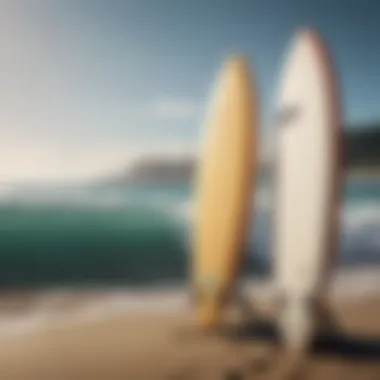
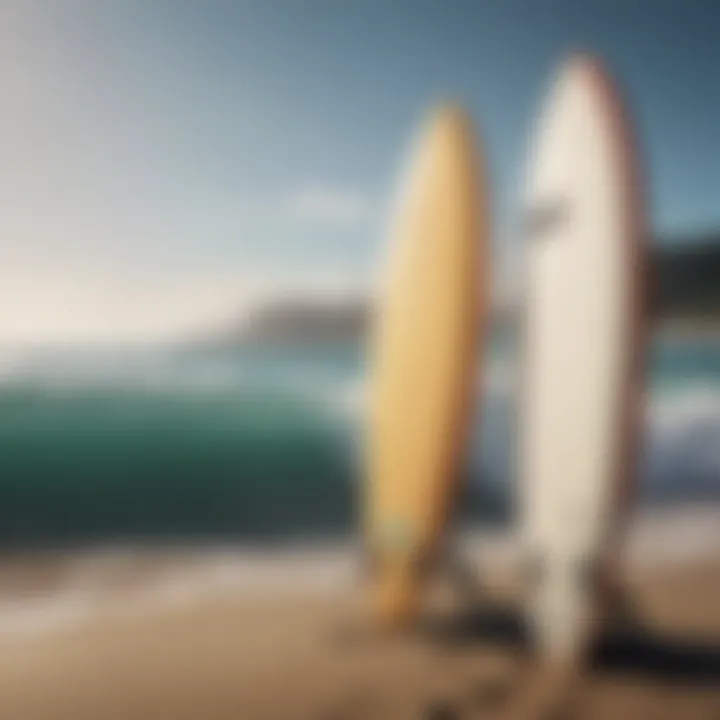
Intro
Embarking on a surfboarding journey is akin to diving into a new world, one filled with exhilarating waves and the calming beauty of the ocean. For many novices, the prospect of catching their first wave can be equal parts thrilling and daunting. With proper guidance, this journey transforms from a mere thrill into an enriching experience. The following sections will methodically cover essential surfboarding techniques, recommended equipment, and the practices that lead to sustainable surfing. Each element is pivotal in building your confidence and enhancing your skills on the board.
Surfboarding Techniques
Mastering the art of surfboarding requires a blend of skill, patience, and the right mindset. As a beginner, a strong foundation in the basics can make all the difference.
Beginner Tips for Mastering the Basics
- Stance and Balance: Before even hitting the waves, take time to experiment with your stance on land. Your feet should be shoulder-width apart. This positioning grants you more balance as you ride.
- Paddling Techniques: Learning to paddle efficiently is vital. Position yourself in the center of the board and use long, smooth strokes. This will help you gain momentum without wasting energy. Think about like a swimmer intentionally gliding through the water—fluidity is key.
- Duck Diving: When catching waves, learning how to duck dive under breaking waves will save you from getting wiped out. This involves pushing your board down as you dive beneath the wave—a crucial skill that can give you an edge when heading out through choppy waters.
- Pop-Up Practice: The pop-up is your transition from lying on the board to standing up. Practice this movement on land first. A swift, smooth movement is essential. Remember, keeping your eyes on where you want to go, instead of staring down at your feet, can be helpful.
"Practice does not make perfect. Practice makes permanent."
— Unknown
Advanced Techniques for Seasoned Surfers
Once you’ve conquered the basics, progressing to advanced techniques will enhance your surfing experience:
- Carving Turns: This involves using your shoulders and hips to shift your weight to change direction fluidly. Sharp turns can be accomplished by flexing your knees and leaning into the turn.
- Bottom Turn: Proper bottom turning positions you for the next maneuver after catching a wave. It's all about generating speed and setting up for the action ahead.
- Aerial Maneuvers: As you become more comfortable, aerial tricks can elevate your surfing. These require the right wave conditions and timing. Start with small jumps and gradually learn how to execute spins and flips in the air.
Surfboard Equipment
With a solid grip on techniques, it’s time to delve into the gear that will support your surfing journey. Choosing the right equipment can greatly affect your performance and enjoyment in the water.
Essential Gear for Every Surfboarder
- Surfboard: Depending on your skill level, different boards work best. A soft-top board can be ideal for beginners due to its stability and safety. As you advance, you might opt for a shortboard or a fish board for better maneuverability.
- Wetsuit: A high-quality wetsuit not only provides warmth but helps maintain buoyancy. The thickness usually varies based on water temperature.
- Leash: This keeps your board connected to you, ensuring it doesn’t float away after a wipeout. A must-have for safety.
- Wax: This is vital for maintaining traction on your surfboard. A little goes a long way in ensuring you don’t slip off while riding those waves.
Reviews of the Latest Surfboards on the Market
In today's surfboard market, options can feel overwhelming. Here are a couple of noteworthy picks:
- JS Industries Monsta 8: This board is popular among intermediate and skilled surfers. It’s designed for high performance in varied conditions - responsive and fast.
- Soft Top Surfboards by Liquid Shredder: Great for beginners, these boards come in various sizes and colors, making them not only functional but also fun to use.
Each equipment choice can shape your experience and should be made with consideration of your skill level and personal preference. Developing a connection with your gear enriches your surfing adventures.
As we journey throughout the rest of this guide, keep in mind that patience*, practice, and a passion for the waves go a long way in advancing your skills. With the right techniques and gear, every time you hit the water, this journey can become a blend of sport and art. Let's dive deeper into understanding ocean conditions and essential skills next!
Understanding Surfboarding Fundamentals
Grasping the essentials of surfboarding is akin to laying the foundation for a sturdy house—it’s critical. Before hopping on that board, you need a firm understanding of what surfing involves, its history, and why it continues to resonate with countless enthusiasts today. Having a solid grasp of surfboarding fundamentals helps in recognizing the art and skill behind the waves. By learning the ropes at this stage, beginners can navigate their journey with confidence and clarity, enhancing their overall experience on the water.
Definition and Origin of Surfboarding
Surfboarding isn't just a sport; it's a blend of skill, craft, and a deep connection to the ocean. The term "surfboard" simply refers to the equipment used to glide over the waves. But delve a little deeper, and you’ll find that it echoes centuries of rich heritage.
Historically, surfing is believed to have originated in ancient Polynesia, with records indicating that it was actively practiced by the natives as far back as the 12th century. The first surfboards were made from heavy wood, making them clunky and difficult to maneuver. However, as culture spread, so did the evolution of the surfboard itself. Modern materials like foam and fiberglass, which emerged in the 20th century, made it exponentially lighter and more agile. This shift revolutionized the sport, opening a world of possibilities for surfers.
Cultural Significance in Modern Society
In contemporary times, surfboarding has transcended its origins to become a global phenomenon. It's not merely about catching waves; it's part of a lifestyle that embodies freedom, adventure, and respect for nature. Surf culture has carved out its niche in music, fashion, and art, prompting a fusion of ideas and expressions that resonate worldwide.
- Connection to Nature: It's about harnessing the power of the ocean and respecting its might. Surfers learn to read the waves, tides, and tides, creating a bond with the environment.
- Community and Belonging: Whether it’s local surf clubs or international competitions, there exists an inclusive community that thrives on shared experiences. Surfing together fosters friendships and a camaraderie like no other.
- Health and Wellness: Surfboarding also promotes physical fitness and mental well-being. Paddling, balancing, and riding the waves engage various muscle groups and provide opportunities for mindfulness and stress relief.
"Surfing is a way to be connected to the ocean, and it's an excuse to have fun!"
In summary, understanding the roots and cultural dimensions of surfboarding is essential for anyone starting this journey. Grasping these concepts fosters an appreciation that transcends mere sport, opening doors to profound personal growth and a deeper environmental awareness.
Getting Started: The Basics of SUP Training
When you're dipping your toes into surfboarding, or as some like to call it, stand-up paddleboarding (SUP), getting a good grasp on the basic training is paramount. The importance of this section can't be overstated, as it sets the stage for everything that follows. A solid foundation in the basics will not just ensure your safety on the water but will also help you progress more smoothly, avoiding the pitfalls that many beginners face.
The right start can propel you forward with confidence, helping you to enjoy the surf experience rather than become overwhelmed by it. With correct knowledge and approach, you’ll find that each paddle stroke brings you closer to mastering the waves.
Choosing the right equipment, understanding various techniques, and knowing key safety guidelines are just a few of the critical elements we’ll cover in this section. Each part contributes widely to the learning curve that every beginner must traverse before they can truly call themselves a surfer.
Choosing the Right Equipment
Types of Boards Suitable for Beginners
Picking the right type of board is crucial for effective learning. For newcomers, a wider and thicker board is often recommended. These features add to stability and offer better buoyancy, making it less daunting to balance while learning the ropes of surfboarding. The shape of the board, particularly the wider stance, allows for more of your weight to be evenly distributed across the surface, decreasing the likelihood of wiping out.
Different types of boards, like the all-rounder boards, are often favored by novices. They strike a good balance between performance and ease of use. This versatility makes them a go-to choice for those just starting out. The unique feature of all-rounder boards is their adaptability to various water conditions, allowing beginners to practice in both flat and choppy waters, an essential feature that can enhance the initial learning experience.
Comparison of Inflatable vs. Solid Boards
When discussing inflatable boards versus solid ones, there's much to consider. Inflatable boards are often viewed as user-friendly because they are lightweight and easier to transport, especially for those who are just starting out. The ability to simply deflate and pack your board into a small carry bag makes them convenient for beginners.
However, they typically don’t offer the same performance as solid boards in terms of speed and responsiveness. Solid boards tend to glide more smoothly over the water and excel in handling waves, making them a popular choice among experienced surfers. For those starting this journey, keeping your goals in mind will dictate which type of board is better for you.
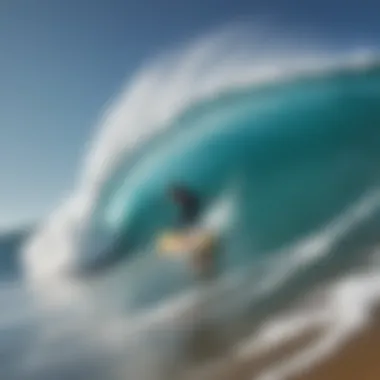
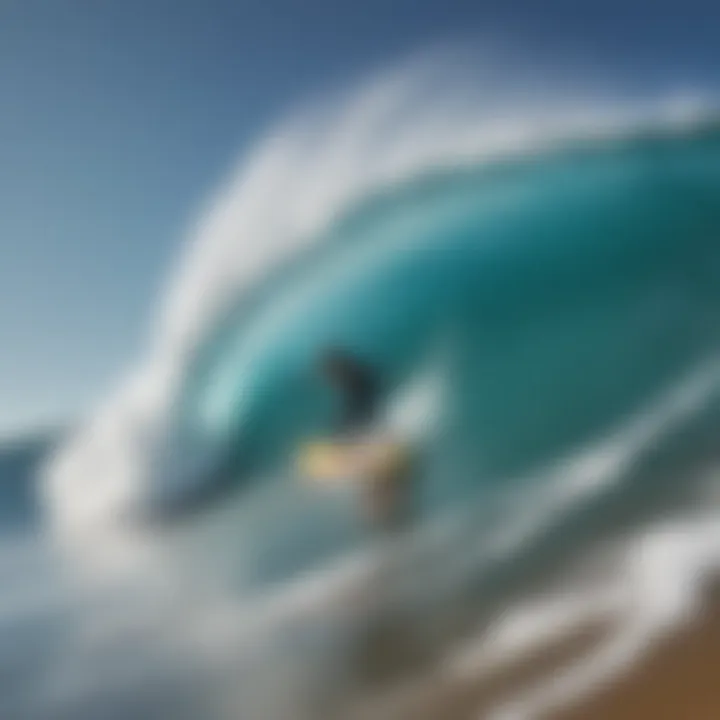
Necessary Accessories: Paddles, Leashes, and Safety Gear
As you gear up for your surfing escapade, don’t forget about the accessories that can make all the difference. A good paddle is essential—not just for moving through the water but for maintaining stability on your board as well. Look for a lightweight paddle that suits your height; this will ease the strain on your arms and provide better reach.
Leashes are just as important; they tie you to your board, preventing it from floating away as you ride the waves. A decent leash also adds a layer of safety, making it easier to reclaim your board if you happen to take a tumble. Plus, they come in different lengths and thicknesses, so selecting one that fits your specific activity level is key.
Safety gear such as personal flotation devices (PFDs) are crucial for ensuring your well-being, especially in unpredictable conditions. Wearing a PFD can ease anxiety and significantly increase your confidence, allowing you to focus on honing your skills rather than worrying about potential mishaps.
Key Safety Guidelines
Understanding Water Safety
Water safety encompasses a range of practices that beginners must adopt to enjoy their time without mishaps. Knowing your surroundings is vital—understanding the currents, tides, and general behavior of the water can mean the difference between a delightful day out and a disaster. It’s imperative to familiarize yourself with local conditions, weather forecasts, and general beach etiquette before stepping onto the water.
A key element in this discussion is the common practice of checking in with lifeguards or experienced surfers to grasp the local water customs. This knowledge-sharing acts as a backbone for enhancing safety, fostering a community-oriented environment.
Identifying Rip Currents and Hazards
Rip currents can be among the most dangerous aspects of water sports. They are fast, narrow channels of water flowing away from shore, often tricky to spot from the beach. Recognizing the signs of a rip current, such as differences in water color or breaking waves, is essential for any beginner surfer. Knowing how to spot these hazards enables you to make informed decisions before entering the surf.
Should you find yourself caught in a rip current, staying calm is vital. Swimming parallel to the shoreline will allow you to escape its grip safely, rather than fighting against the current.
Importance of Wearing a Personal Flotation Device
Lastly, never underestimate the value of wearing a personal flotation device, or PFD. This safety equipment plays a crucial role in supporting beginners, helping them feel secure as they learn. Whether you’re paddling in calm waters or taking on turbulent waves, a PFD can ensure that you stay afloat should you find yourself in a challenging situation.
The unique feature of modern PFDs is their design for versatility and comfort. You won’t have to worry about it restricting movement or becoming cumbersome as you board or paddle.
Techniques and Skills Development
Techniques and skills development is the cornerstone of any beginner's journey into surfboarding. Understanding the various skills required to navigate the waves not only builds confidence but also enhances safety and enjoyment on the water. A solid foundation in techniques can significantly affect how quickly one progresses and enjoys this exhilarating sport. By focusing on core skills like balance, paddling, and maneuvering, novices can forge a more effective and safer path in their surfboarding adventure. With a little patience and practice, anyone can master these essential elements.
Mastering Balance on the Board
Posture and Weight Distribution
When it comes to posture and weight distribution, it’s all about finding that sweet spot. Balancing on the board requires an understanding of how to distribute your weight evenly. Good posture helps in keeping your center of gravity low, which is crucial for maintaining stability. Planting your feet shoulder-width apart creates a solid base, ensuring you won’t wipe out at the first bump.
Key characteristics of proper posture include bending your knees slightly, keeping your back straight and aligning your head over your feet. This not only aids in balance but allows for quick adjustments to your stance when the waves start rolling in. It is a popular choice in this article because poor weight distribution can lead to unnecessary tumbles—so it’s worth spending time on.
Unique features of weight distribution involve shifting your weight slightly forward to catch waves faster, or leaning back to maintain stability on bigger swells. Mastering this can lead to greater confidence on the board. However, it’s essential to practice in calm conditions before tackling larger waves, as misjudgments can lead to falls or even injuries.
Dynamic Movements while Standing
Dynamic movements while standing deal with adjusting to wave actions and other surfers around you. When standing up on your board, it’s crucial to be responsive. This means being ready to sway, pivot, and shift your body without losing control. Think of your board as an extension of your body, and learn to move with it fluidly.
One of the notable characteristics of dynamic movement is incorporating your arms for balance. If you lean too far in one direction, extend your arm on the opposite side to maintain stability. That’s a trick many experienced surfers swear by—it's all about instinctual reactions.
The unique feature here is that dynamic movements can actually enhance a surfer's ability to read the waves and respond quickly. If you practice these movements regularly, you’ll find that weaving through waves becomes second nature. But be cautious, as excessive or overly abrupt movements can lead to loss of balance, especially when you are starting out.
Paddling Techniques for Beginners
Grip and Hand Position
The grip and hand position you adopt while paddling heavily influence your efficiency and stamina. A relaxed grip is essential; too much tension can lead to fatigue and poor technique over time. Positioning your hands shoulder-width apart on the paddle offers more control and makes every stroke smooth and powerful.
One key aspect of grip is to keep your wrists straight, avoiding any awkward angles. This approach alleviates unnecessary strain on your joints and facilitates a more fluid paddling experience. So, when considering grip, remember: comfort should always come first in your paddle strokes.
A unique feature of proper hand positioning is the ability to angle your paddle slightly to create more thrust during each stroke. This aids in faster and more efficient cuts through the water. However, bear in mind that angry chop or waves may require adjustments in technique, as the direct grip may not always provide the most stability.
Strokes and Timing
Strokes and timing are the pulsing heartbeat of paddling. Getting these elements right ensures a smooth and effective ride. The timing of your strokes is paramount—whether you are trying to gain momentum for catching a wave or navigating back to shore after a ride, understanding when to paddle and when to rest is vital.
An effective stroke requires a deep and consistent pull through the water. It’s not about how fast you can go, but rather how efficiently you move—this is a common misconception among beginners. Timing gives you an edge; knowing when to increase or decrease your paddle speed affects how you interact with oncoming waves.
A striking feature of mastering this skill is how it contributes to your overall rhythm on the board. Synchronizing paddling with waves can lift your experience from average to exceptional. However, overexertion during paddling can lead to quick exhaustion, especially for fresh faces on the surf scene.
Turning and Maneuvering
Turning and maneuvering involve developing an instinctual feel for the board and the water. You’ve caught a wave, and now what? Navigating through it effectively is where turning becomes crucial. To execute a proper turn, lean into the direction you wish to go while shifting weight toward your toes or heels—simple but effective.
A key characteristic here is how turning can help you avoid obstacles and position yourself optimally for the next wave. By practicing small turns first, beginners can secure greater confidence. It’s beneficial because knowing how to maneuver makes you a more competent surfer.
An interesting element of turning is its relation to wave selection. Different waves call for different techniques, meaning being adaptable is essential. On the downside, overly aggressive turns may lead to instability and falls, which can be discouraging early on.
Appropriately develop your techniques, and soon you won’t just be riding waves; you’ll be playing in the dance of the ocean.
By concentrating on achieving mastery in these areas, beginners set themselves up for a rewarding surfboarding experience, turning the learning curve of surfing into a smoother, enjoyable ride.
Understanding Ocean Conditions
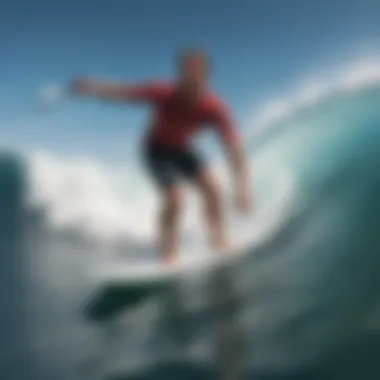
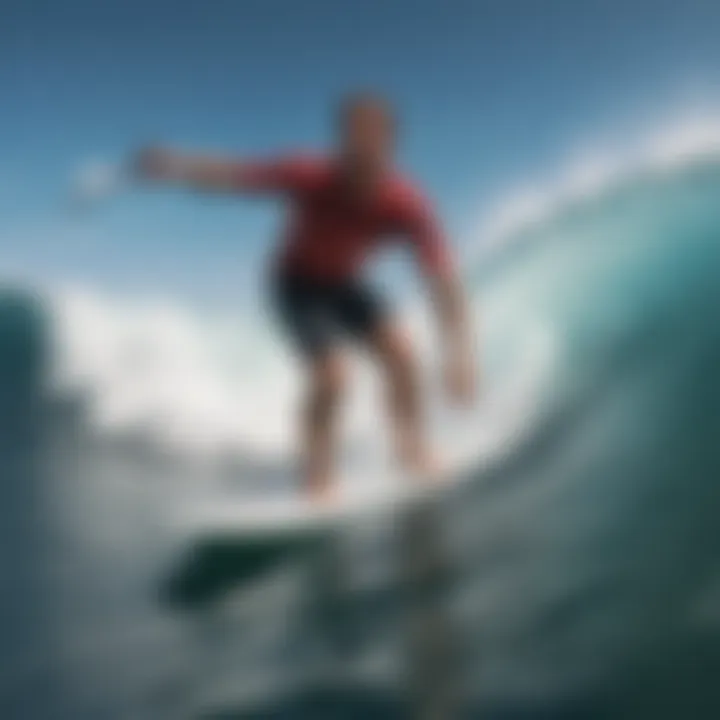
Understanding the ocean is crucial for any beginner in surfboarding. It’s not just about catching waves; it’s also about respecting the unpredictable nature of the sea. The ocean is a dynamic environment that changes with tides, currents, and weather patterns. Knowing how to read and understand these conditions can be the difference between an enjoyable experience and a dangerous outing.
Tides and Their Impact on Surfboarding
Tides, which are caused by the gravitational pull of the moon and sun, play a significant role in surf conditions. They affect the wave sizes, currents, and even the ocean floor.
When the tide is high, waves often break differently than during low tide. Higher tides might provide gentler waves, making it easier for beginners to practice their paddling and riding skills without feeling overwhelmed. Conversely, low tides can expose rocky bottoms, increasing the risk for inexperienced surfers.
There are generally two types of tides—spring and neap tides. Spring tides occur when the gravitational forces of the sun and moon align, leading to higher high tides and lower low tides. In contrast, neap tides happen when the sun and moon are at a right angle, resulting in less extreme tidal changes. Surfing is usually better during neap tides for beginners, as the waves are more consistent and manageable.
Reading Waves: A Beginner's Guide
A fundamental skill for any surfer is understanding waves and how they break. Waves are not just walls of water; they have structure and personality. Recognizing different types of waves is essential for beginners.
Wave Anatomy and Types
Waves consist of several parts, including the crest (the top), trough (the bottom), and face (the rideable part). Each wave type has unique characteristics:
- Beach Breaks: Waves that break over sandy bottoms. These are generally safer for beginners since the sand provides a soft landing.
- Point Breaks: Waves that wrap around a point, creating a long ride. These can offer unparalleled surfing experiences but require some confidence due to their sometimes powerful nature.
- Reef Breaks: Waves that break over reefs. Not ideal for beginners because they might lead to injuries if a fall occurs.
Learning to identify these types of waves will help beginners choose the right spots to practice.
Optimal Conditions for Beginners
For beginners, the best surfing conditions are gentle, consistent waves, typically found in smaller swells or during calmer weather.
- Look for days when the surf report indicates small wave heights, generally in the 1-3 foot range. These smaller waves make it easier to learn proper paddling, standing, and riding techniques.
- Wind conditions also matter; offshore winds create cleaner waves, while onshore winds can make the surface choppy and challenging to navigate.
In summary, understanding ocean conditions, recognizing tide cycles, grasping wave anatomy, and knowing when conditions are right to surf are foundational skills. They not only enhance safety but also elevate the entire surfboarding experience, allowing beginners to gain confidence and skill in their chosen sport.
Expanding Your Knowledge
Expanding your knowledge in surfboarding is like filling a toolbox before starting a big project. For beginners, knowing what you are getting into opens doors to safer, more enjoyable experiences on the water. The broader your understanding, the more equipped you'll be to navigate challenges, from selecting the right equipment to making friends in the surf community.
There is a certain charm in sharing experiences and wisdom with those who have been there, done that. Engaging with more experienced surfers not only gives newcomers a treasure trove of practical insights but also helps foster a sense of belonging in the world of surfing. Let’s break down how to immerse yourself in this vibrant culture and create lasting connections.
Learning from Experienced Surfers
Joining Surf Camps and Workshops
Participating in surf camps and workshops offers a hands-on approach to learning that reading cannot replace. These gatherings often take place in scenic locations, allowing participants to connect with nature while honing their skills. A big draw to these camps is the expertise of instructors who tailor their lessons to different skill levels—from beginners to more experienced surfers wanting to refine their techniques.
One of the key characteristics of these camps is the community aspect. Camping or learning together builds camaraderie, which is particularly uplifting for newcomers. You’ll find a mix of laughter, joy, and camaraderie that makes challenges seem minor. However, it’s essential to consider that these camps often come with a price tag. In some regions, they can be a bit steep, especially for longer sessions. Yet, the friendships and skills gained may be worth every penny.
Finding Mentorship in the Surf Community
Finding a mentor can be a game-changer for beginners. Having someone to guide you—whether it’s a seasoned surfer or a coach—provides valuable perspectives that can’t easily be found in books or online videos. This mentoring relationship can kick-start your learning process. In surf communities, this often happens organically through shared experiences at the beach or during lessons.
The key characteristic of mentorship is the personalized feedback you receive. While a workshop may cover general techniques, a mentor can pinpoint your strengths and weaknesses, offering tailored advice that helps you grow. The unique feature of this approach is the ongoing relationship that develops. You get support not just for a few days or weeks but could form a lasting bond with someone who genuinely invests in your progress.
However, keep in mind that finding the right mentor may take some time. Not everyone will match your personality or learning pace. Therefore, it’s wise to attend various events and meet different surfers before settling on one.
Resources for Ongoing Learning
Books and Guides
Books and guides provide a wealth of information from the comfort of your home or even while lounging at the beach. What sets them apart is the depth of knowledge they can offer. A good surf book might cover everything—techniques, surf culture, ocean dynamics, and personal stories from experienced surfers.
The key characteristic of books and guides is their availability. With a simple online search or a visit to a local bookstore, you can find countless resources. Whether you're looking to understand ocean currents or perfect your paddling technique, there is usually a book written by an expert on the topic.
On the flip side, the unique feature is that books can sometimes feel overwhelming, especially for beginners. With so much information, it can be tricky to know where to start. Therefore, it helps to read recommendations from fellow surfers or instructors.
Online Courses and Tutorials
Digital learning has reached new heights, and online courses or tutorials have emerged as a useful tool for aspiring surfers. The beauty of these resources is their adaptability; you can learn at your own pace and revisit challenging sections as needed. Many courses are structured to break complex concepts into bite-sized, manageable pieces.
Their key characteristic is convenience. No need to worry about fitting classes into a busy schedule. Whether you’re stuck in traffic or enjoying a lazy Sunday, you can pick up your phone or laptop and dive into a series of lessons whenever you want.
Nevertheless, it’s crucial to consider that not all online resources are created equal. You might come across piecemeal tutorials lacking cohesion or depth. Therefore, it's wise to choose established platforms or courses with strong reviews to ensure that what you're learning is both accurate and beneficial.
Promoting Eco-Conscious Surfing Practices
As the waves beckon and surfers line the beaches, it's not just the thrill of riding the surf that captures attention. There's a heavier tale beneath the surface—one that speaks of our environment and the lasting impact that our activities can have on it. Promoting eco-conscious surfing practices becomes pivotal not only for the sustainability of our beaches but also for the overall health of our oceans. By nurturing a framework that emphasizes environmental responsibility, surfers can enjoy their passion while safeguarding aquatic ecosystems for future generations.
Understanding Your Environmental Impact
Surfing is often seen as a way to connect with nature, yet it can contribute to ecological disturbances if we’re not careful. The environmental footprint of surfboarding largely stems from the materials used, the waste produced, and the pollutants that find their way into the waters.
Consider the chemicals leached into oceans from traditional surfboard manufacturing. The polluting materials can harm marine life, disrupting delicate ecosystems. Being aware of these issues not only raises consciousness but also inspires mindful practices among surfers. Such practices can range from responsible disposal of wax and plastics to choosing to paddle in less crowded spots to reduce wear on marine habitats.
Choosing Sustainable Equipment
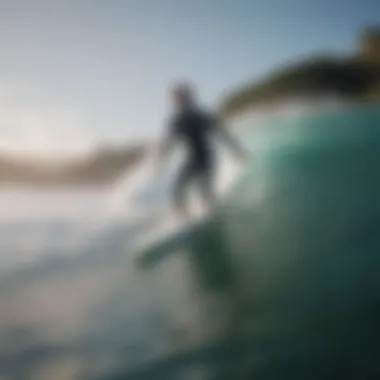
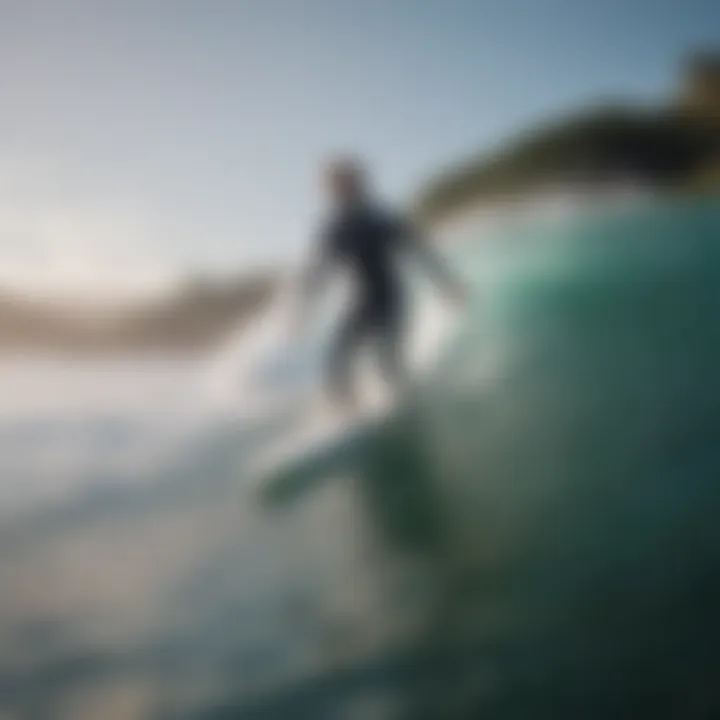
When setting out on your surfboarding adventure, the gear you select does bear weight—quite literally. Sustainable options are increasingly available, encouraging surfers to make choices that align with both performance and the planet. Two crucial subcategories under sustainable equipment are eco-friendly materials and secondhand or rental options.
Eco-friendly Materials and Manufacturing
The shift towards eco-friendly materials can tremendously impact the footprint of surfboards. Materials such as bio-resins, which come from renewable sources, minimize reliance on petroleum-based products. These resins break down faster in nature than traditional fiberglass, making them a more planet-friendly choice.
Key characteristics include:
- Reduced Carbon Emissions: Manufacturing processes that utilize sustainable materials generally produce less CO2.
- Less Harmful to Marine Life: Boards made with eco-resins don't leach harmful chemicals into the water.
This choice is beneficial for both the surfer and the environment; it’s a win-win situation. Yet, it’s important to note the limitations too:
- Availability: Eco-friendly surfboards may not be as widely accessible as traditional ones, requiring more effort to source.
- Price Factor: Usually, these boards come at a higher price point due to the production techniques.
Secondhand and Rental Options
Buying secondhand or renting surf gear is another sustainable alternative that can significantly decrease environmental impact. By opting for previously owned boards, surfers are reducing waste and lessening the demand for new products. This choice is particularly beneficial for beginners, who may not yet be ready to commit to a long-term investment in gear.
Key characteristics include:
- Cost-Effective: Renting or buying used gear can help save a pretty penny, especially for newbies still figuring out their preferences.
- Less Resource Intensive: Fewer new boards mean a decrease in raw materials needed for manufacturing, easing pressure on environmental resources.
The uniqueness of this approach lies in its flexibility:
- Test Different Gears: Renting allows you to try various boards, helping you understand what works best for your style.
- Community Connections: Purchasing secondhand gear often leads to new relationships within the surf community.
However, be mindful:
- Quality Checks: Used gear may require more scrutiny to ensure its safety and longevity.
- Potential Sizing Issues: Finding the perfect fit can be challenging when browsing secondhand.
Main takeaway—make choices that uplift your surfing experience without dragging the environment down. Embrace eco-conscious surfing practices and actively participate in protecting the oceans that give so much to us.
Building Community and Connection
Building community and connection in the realm of surfboarding is fundamental for anyone starting this exhilarating journey. It fosters a sense of belonging, enhances learning, and amplifies the joy of the sport. Surfboarding is not done in isolation; it thrives in a community where shared experiences, encouragement, and collective knowledge uplift everyone. Developing these connections can greatly enrich the learning experience, making challenges seem smaller and victories even sweeter.
Engaging with Local Surf Culture
Participating in Surf Events and Competitions
Participating in surf events and competitions serves as a vibrant gateway into local surf culture. These events can be a mix of friendly competitions and social gatherings, showcasing a blend of skill and camaraderie. Anyone can get involved, whether as a competitor or a spectator. The key characteristic of these events is that they allow beginners to witness seasoned surfers in action, right from the get-go. It’s a humbling experience that provides insight into techniques and styles not found in textbooks.
More than just competition, these events nurture a sense of community. They offer opportunities to meet like-minded individuals who share your passion for riding the waves. Plus, it’s common to find workshops or clinics running alongside these events, broadening your skills. One unique feature of engaging in such events is the chance to learn surf etiquette - a vital part of the culture. However, the pressure to perform can sometimes be daunting, particularly for beginners, making it essential to approach these events with the right mindset and an understanding that growth comes with time.
Network with Other Beginners
Networking with other beginners enhances the sense of community while also providing a support system. Sharing your struggles and triumphs with others who are at the same stage builds rapport and comfort. The key characteristic of this networking is its informal nature, allowing for relaxed exchanges of tips and techniques without the intimidation that can accompany more seasoned surfers.
By connecting with fellow beginners, you encourage each other to step out of comfort zones, try new things, and tackle challenges as a team. One unique aspect is the potential for forming study or practice groups where you can collectively work on improving skills together. However, a downside may include feeling overwhelmed by different opinions and styles, which can be counterproductive. It's essential to filter advice and focus on what resonates with your personal surf journey.
Utilizing Online Platforms and Forums
Sharing Experiences and Tips
Sharing experiences and tips on online platforms can catalyze your learning process. These forums create a virtual village where surfers, regardless of their location, can exchange thoughts, ideas, and insights. The key characteristic of these platforms is their accessibility; anyone can log on and contribute to discussions or seek advice from seasoned experts.
Engaging in such communities not only broadens your perspective on surfboarding but can also enhance problem-solving skills. A unique feature of these interactions is the ability to receive real-time advice tailored to your specific questions or issues, from gear recommendations to safety tips. However, the vast amount of information can sometimes lead to confusion. It’s important to identify credible sources and maintain a discerning approach.
Learning from Online Communities
Learning from online communities adds another layer to your surfboarding development. Many platforms, like Reddit and Facebook groups, host dynamic discussions that can elevate your understanding of surf culture and techniques. The key here is the diversity of experiences shared; you’ll encounter a range of stories from people who have traveled to various surf spots and battled different conditions.
This exchange of knowledge can prove immensely beneficial. Unique features of these online communities include the option to watch tutorials and demonstrations from experienced surfers, giving you practical insight. However, it's vital to remain aware of the differing skill levels among community members. Knowing that everyone’s path is unique can help manage expectations as you learn from various perspectives.
Building connections, whether on the beach or through your screen, can significantly shape the surfboarding journey, offering both practical skills and emotional support as you navigate the waves.
Ending: The Journey Ahead for Beginners
As you wrap up the foundational knowledge of surfboarding, it's paramount to recognize that the journey ahead is just as vital as the starting point. This conclusion isn't merely a tidy ending; rather, it serves as a capstone that ties together everything explored in the previous sections. Whether you're surfing the coasts of Hawaii or riding the mellow waves of a local lagoon, addressing what lies ahead equips you with a roadmap for continued growth.
Not only does this part highlight the importance of ongoing learning, but it also emphasizes setting achievable targets. A major takeaway is that success isn’t defined by catching perfect waves but rather in the incremental improvements made as you ride this learning curve. Focus on the process, and each small victory can amount to significant progress.
"Patience is bitter, but its fruit is sweet." In the context of surfboarding, this aligns perfectly with the need for realistic goal-setting and the persistence to navigate through both the challenges and victories on the water.
Setting Realistic Goals
When diving into any new sport, especially one as unpredictable as surfboarding, setting realistic goals becomes crucial. Many beginners may dream of riding massive waves or performing intricate tricks right out of the gate, but it’s essential to keep your expectations grounded.
- Focus on Foundational Skills: Begin by aiming to master balance and paddling techniques. This translates to enduring practice sessions where simply staying upright becomes a feat worth celebrating.
- Start Small: Create specific, achievable goals like practicing standing on your board for a set duration or paddling for a certain distance. Gradually introduce challenges as you grow in confidence and skill.
- Track Your Progress: Maintain a journal or use an app to document your growth. Reflection on your journey can inspire and motivate you, revealing how far you’ve come over time.
Remember, the waves may not always be perfect, and conditions can be unpredictable. Embrace the idea that reaching these realistic goals, no matter how minor they seem at first, will build a solid foundation for the more complex maneuvers and dynamic conditions you will encounter.
Cultivating Persistence and Adaptability
Cultivating persistence is crucial not only in surfboarding but in any endeavor. The ability to adapt to changing environments is your ally in overcoming hurdles.
- Embrace Setbacks: Falling off your board is part of the journey. It might feel discouraging, but viewing each wipeout as a learning opportunity is essential. Analyze what went wrong, and make adjustments.
- Flexibility is Key: Conditions can shift rapidly, requiring you to rethink your approach. Whether it’s tide changes or varying wave patterns, being adaptable allows you to thrive under different scenarios. For example, if the surf is too rough, head to a calmer spot and work on paddling or core strength.
- Mental Strength: Surfboarding can be mentally taxing. Develop a mindset that values resilience, reminding yourself that progress isn't always linear. Celebrate small wins and stay focused on your long-term goals, even when the going gets tough.















